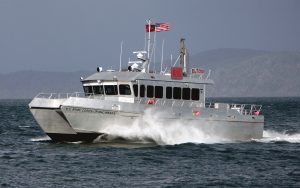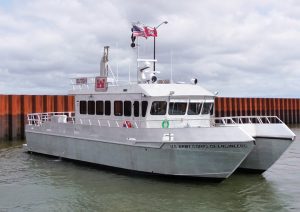
For the last year, West Coast shipping news has been dominated by the huge assortment of container ships waiting to unload Asian imports in southern California, but the spotlight may eventually turn to a very different cargo—American wheat for export.
This vital commodity rarely attracts much attention, but the hostilities between Russia and Ukraine are expected to reduce the world grain supply significantly this year. The USA and Canada each supply around 14% of the wheat on the world market in a typical year, while Russia exports 18% and Ukraine 8%. The loss of any of this grain could have huge repercussions for many Third World countries, so the World Food Program has already begun searching for additional supplies of wheat—like the USA’s strategic grain reserve.
Many Northwest ports handle grain, but it’s the main export for the Columbia River ports in Portland, Oregon and Vancouver, Kalama and Longview, Wash., which together comprise the nation’s leading gateway for grain exports.
They’ve invested heavily to modernize their equipment, as have the Portland District of the U.S. Army Corps of Engineers, which now uses a pair of high-speed hydrofoil survey boats with the latest electronic gear to ensure the depth of 43 feet is maintained along the entire 103-mile shipping channel. They are one part of the marine transport system that is the key to the region’s economic success and ability to compete with the Puget Sound and British Columbia deepwater ports.
Since the first sailing ship was loaded with wheat in 1868 and sailed around Cape Horn to Liverpool, the channel has been dredged numerous times to keep up with the increasing size of cargo ships. The technology used by the surveyors and the dredge team has also improved dramatically.
In 1873, the Corps of Engineers used lead lines to find the depth and a small steam-powered dredge to provide “17 feet of safe water,” which supported over 175,000 tons of freight traffic in 1875. The two jetties at the river mouth were completed around the time of the Panama Canal opening in 1914, which had a major impact.
The Panama Canal locks had a maximum draft of 39.5 feet and encouraged a new era in shipping with bigger, faster steam ships that required more dredging of the Columbia. It eventually forced naval architects and ship owners to create the modern “Panamax” class with draft limited to 39.5 feet and length 650-720 feet to fit the Panama Canal.
Many of these ships have a cargo capacity of 60,000 to 80,000 tons and were unable to fully load at the Columbia River until Congress finally approved a bill to deepen the river to 43 feet and 600 feet wide, which took from 2005 to 2010 and cost $178.4 million.

The Corps’ Portland District recognized that it would need the latest technology in fast work boats and depth sounding instruments to survey the new channel and record the precise depth of water and location of any newly forming sand bars. Two high-speed catamarans were ordered from a specialist aluminum builder in Louisiana. The design, 59.5-foot long by 23.5 foot wide, featured a wing-like hydrofoil amidships suspended between the twin keels. The draft is only 3.25 feet. In 2010, they were shipped on a yacht-transport ship from New Orleans to Victoria, British Columbia where they were off-loaded and motored around the coast of Washington to Portland.
They were christened Elton and Redlinger after two long-serving managers of the Corps’ dredge program, and the first trials proved that the twin-hull foiling approach provided a fast, stable platform for monitoring channel and harbor conditions while using the Reson multi-beam sounder and Odom hydrographic single-beam sounder.
All the transducers are mounted on a vertical strut that is lowered into the river through a well in the center of the aft deck. This gives easy access to the entire electronics system and keeps the delicate underwater unit safely out of the water during high-speed transits.
Propulsion is by twin MTU Series 60 diesels producing 1,200HP at 2300 rpm, and turning Hamilton 404 waterjets via Twin Disk reduction gears, giving a top speed of 36 knots, and cruising speed of 20-25 knots. Service power is provided by a pair of Northern Lights 12 kW generators. The design features a Hysucraft hydrofoil wing amidships suspended between the twin hulls’ keels. Above 20 knots, this foil raises the bows and lowers hull drag.
Above 30 knots, the foil supports about half the 30 long-ton displacement, resulting in a faster and smoother ride to the survey area. This reduces crew fatigue in a seaway and reduces fuel consumption by 10-15% at cruise speed.
After a decade of service, both boats’ navigation suites were upgraded in 2020 with the latest Furuno electronics including the Furuno VHF-FM-4800 radio and AIS.
“I would say that the upgrade to navigation system in 2020 with the new radios was the biggest improvement in the boat’s performance,” Portland District boat operator Tyler Bartel said.
By 2021, 47.5 million tons of cargo was exported via the Columbia River, valued at $18 billion, supporting more than 40,000 jobs in two states—and both boats had put over 10,500 hours on the engines and waterjets. They were due for scheduled overhaul and maintenance, plus a re-design of the four engine-room hatches to resolve leakage into the engine rooms.
The Redlinger was overhauled in the fall of 2021 at WCT Marine on the Tongue Point Shipyard in Astoria, and the Elton was hauled out in January 2022 into the large hangar originally erected for U.S. Navy seaplanes in 1940.
WCT Marine is a full-service yard that provides the only haul-out and repair service close to the mouth of the Columbia River for tugs and barges, fishing vessels, Coast Guard-certified passenger vessels, etc.
The engines were checked and serviced, the shafts re-aligned and the U-joints removed and overhauled. WCT’s engineering team had devised a solution for the deck hatches that involved welding additional support under the coamings to eliminate the through-bolts that were allowing water to find its way below.
In addition, the gaskets on all eight Freeman access hatches were replaced to maintain watertightness. Below the waterline, the hydrofoil and seacocks were inspected and a total of 20 anodes were removed and replaced on the waterjets.
“With 12 years’ experience operating both Elton and Redlinger, I can say that they are a very stable craft in calm-to-moderate seas (of 0-4 feet), said Will Johnson, Portland District boat operator. “In seas above that, they can tax your stamina. Handling swells on the ocean can be done up to around six feet. They can and have operated beyond 10 feet but only when returning to safe haven. They are highly maneuverable craft and will go any direction when in tight quarters.”
“The work at WCT fixing the engine room soft patches made a tremendous improvement for keeping the salt water from seeping in and damaging our engine room,” Bartel added. “It will save in future maintenance costs and man hours. WCT contractors were knowledgeable and great to work with.”

